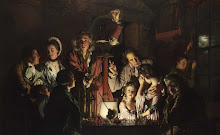At this current moment, we are in the modern art era. Will we ever rename this era? If so, what else could we call it? What would have to happen for us to make that decision? I am not sure, and I don't think I will ever be able to answer that question.
Artwork from the post-World War II era is probably my favorite. It just so happens that my favorite artist of all time comes from that period. Let me tell you how I came to admire Andy Warhol.
During my senior year of high school in 1997, I attended a technical school for graphic design in Traverse City, Michigan. The program consisted of three different teachings spaced throughout the school year: sketching/drawing/painting, computer editing/manipulation, and printing. Additionally, I was taking an advanced art class at my high school, spending three-quarters of my day engrossed in art. It was in these classroom settings that I learned about Andy Warhol. One of the assignments in my advanced art class was to draw a piece of paper from a hat with an artist's name written on it. Whichever artist you drew, you had to choose one of their works and emulate their style. I drew Andy Warhol.
I had no idea who he was, so I went to the library to research and look into his works. At first, I thought his works were plain and simple and that the assignment wouldn't be difficult. I was wrong. Fortunately, I was in the printing portion of the class at technical school, where I had access to a silk screen printer. Lucky me! I wanted to emulate the Campbell's soup can in some way, so I went to the local grocery store and picked up a can of generic soup. I drew it, scanned it into a computer, edited it in Photoshop, and created a file to produce a silk screen print. After printing it, I added some painting to make it my own style and submitted it to my teacher. It was a great success, and my teacher was very proud of my submission.
Andy Warhol, Campbell's Soup 1, 1968
The very first soup cans Warhol created were actually painted. It wasn't until later that he decided to mass-produce them using a printing press, which allowed him to produce several works at a time. You can definitely see repetition in this work, a hallmark of his style. He is the reason "Pop Art" exists. The shape of the can and the label repeat, with only the type of soup changing. The contrast is simple and pleasing to the eye. Warhol wanted to take everyday items that everyone knew and took for granted. Growing up, he ate Campbell's soup every single day. Now, imagine the intimacy he had with these cans. He probably examined them daily, reading the label before peeling it off to recycle. Just seeing the words on the cans likely brought back the taste for him. It may seem simple to us, but it symbolizes something that sustained him for a long time.
Andy Warhol, Brillo Soap Pad Boxes, 1964
The next work of Warhol I would like to highlight is "Brillo Soap Pad Boxes." This time, he created a sculpture. He built the sculpture out of plywood and silkscreened the Brillo pad boxes onto it. Even though he transitioned to sculpture, you can still tell it is one of his works based on the silkscreen method, repetition, and contrasting colors.
While doing my research on Warhol, I got to see other artists works. While skimming one of the books on modern artists (at the time), I got to see some risque photos painted to look like comics. I loved comics, except they were nude women. So as a young, hormone filled young man that had no idea what was going on with his body got to looking at Lichtenstein's works. If you are not familiar with his works, go ahead and look up "Blue Nude" and you will understand why this poor boy was so intrigued. I will keep this more tame and have us look at a couple of his more, not so provocative works.
Roy Lichtenstein, In the Car, 1963.
Another aspect of Lichtenstein's works that caught my eye was how they were made to look like old comic book prints. These works resembled silk screen prints, but they were all painted. I couldn't believe how meticulous his works were. I didn't believe they were painted. Take a look at the above work; it was from a comic book, but he enlarged it as a painting. For comics to be readable, the images had to be very contrasting, and Lichtenstein correctly portrayed that. You can see the lines indicating the movement of air as the car moves. The thick, bold lines that define their faces and the waves of hair really stand out. The emotions on both of their faces are very clear. I truly thought I was looking at a comic book panel.
Roy Lichtenstein, This Figure is Pursued by That Figure, 1978
Later in his career, Lichtenstein started producing more abstract works. It's rare to see artists radically change their style, but he did. Moving from highly detailed works and pointillism, he transitioned to wavy, geometric, and abstract shapes with bold, thick lines. I've never been one to understand abstract art. To be honest, it's not something I particularly enjoy looking at.
One thing I tend to shy away from is sculpture. I'm not sure why; maybe I find it too complicated and prefer to stick to paintings or drawings. However, I'm going to step out of my comfort zone and explore a couple of sculptures, specifically in the form of installation art.
As a middle-aged man, I remember that one of the topics that brought about jokes and ridicule when I was younger was the feminist movement. I’m not sure why it was met with such derision. I was raised to respect everyone, regardless of gender, race, or religious views. I was taught to honor all walks of life equally. So, I was bewildered to see that not everyone shared the same perspective.
Let's look at a couple of works that I found intriguing.
Judy Chicago, The Dinner Party, 1974-1979
I want to focus on a couple of points about this sculpture, which took the artist six years to create. Describing every detail would take me hours or even the whole day. The table features place settings for 39 women throughout history. Each side of the triangle represents different eras: Wing I honors women from Prehistory to the Roman Empire, Wing II covers women from the beginnings of Christianity to the Reformation, and Wing III includes women from the American Revolution to feminism. The center of the table consists of triangles with the names of 998 notable women and one man. The man was a sculptor who was once thought to be female.
Each place setting includes a table runner embroidered with the woman’s name and images or symbols related to her accomplishments. It also features a napkin, utensils, a glass or goblet, and a plate. The plates are adorned with butterfly or flower-like paintings or sculptures that represent a vulva, symbolizing women's achievements in textile arts and china painting. Often, such works are viewed as "low art" compared to the "high" or "fine art" traditionally produced by men. Notably, only one place setting is dedicated to a Black woman. Her setting replaces the vulva representation with three faces, which some interpret as a commentary on how Black women's contributions are often marginalized or overlooked, or as a critique of white feminists' views on Black women's identity. There's indeed a lot to unpack in this work.
While it may not be a painting I would sit and stare at for a long time, I would really like to see this piece in person to appreciate all the details up close. I believe the admission price would be well worth it to spend hours breaking down and examining this intricate work.
Let's take a look at something that makes many men uncomfortable: menstruation.
In 1972, a teacher and co-educator, along with a group of students, transformed a dilapidated house into a large installation piece dedicated to the feminist movement. The house was aptly named "Womanhouse."
Judy Chicago, Womanhouse, 1972
Here is the front of Womanhouse. You can see Judy Chicago and Miriam Schapiro sitting by the entrance.
Judy Chicago, Menstruation Bathroom from Womanhouse, 1972
I’m not sure why menstruation is so often met with disgust by men. It’s a natural part of a woman's life and should be normalized rather than hidden behind closed bathroom doors and avoided in conversation. Growing up with my mother and two younger sisters, I was familiar with the topic, though not to this extent. Even in our home, it was something kept private and not openly discussed with boys or men.
The way we celebrate a boy becoming a man versus a girl becoming a woman is strikingly different. For girls, the transition often involves secrecy and solitude, as if we want them to feel ashamed of their menstrual cycle. Alternatively, is it that women prefer solitude and privacy during this time? This pristine white ceramic bathroom aims to reveal what we have been hiding, challenging both men and women to see that there is nothing to be ashamed of.
When I was younger, my friends found it strange when I would go to the store to pick up feminine products for my mom or sisters. I didn’t see it that way; I viewed it as helping out my family. I felt no shame in it. If anything, I was empathetic to the pains and cramps my sisters and mother experienced during their periods and wanted to ensure they felt comfortable. If only more men could think like that.
Chicago, J. (1972) Womanhouse, menstruation bathroom (site installation), Womanhouse, Menstruation Bathroom (site installation). Available at: https://dome.mit.edu/handle/1721.3/2403 (Accessed: 03 August 2024).
Dean, M. (2020) The story of Andy Warhol’s ‘Campbell’s Soup Cans’, Sothebys.com. Available at: https://www.sothebys.com/en/articles/the-story-of-andy-warhols-campbells-soup-cans (Accessed: 03 August 2024).
The Dinner Party by Judy Chicago (no date) Brooklyn Museum. Available at: https://www.brooklynmuseum.org/exhibitions/dinner_party (Accessed: 03 August 2024).
Lichtenstein’s difference (no date) Castelli Gallery. Available at: https://www.castelligallery.com/blog/lichtensteins-difference (Accessed: 03 August 2024).
Selected work " Judy Chicago (no date) Judy Chicago. Available at: https://judychicago.com/gallery/womanhouse/pr-artwork/ (Accessed: 03 August 2024).
Studio (no date) Roy Lichtenstein, Studio International: Visual Arts, Design and Architecture. Available at: https://www.studiointernational.com/index.php/roy-lichtenstein (Accessed: 03 August 2024).
Warhol, A. (1964) Brillo soap pads boxes, 1964 - Andy Warhol, www.wikiart.org. Available at: https://www.wikiart.org/en/andy-warhol/brillo-soap-pads-boxes-1964 (Accessed: 03 August 2024).



.jpeg)





Comments
Post a Comment